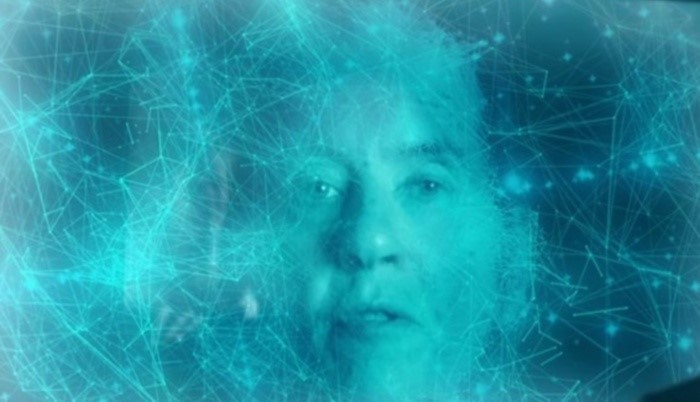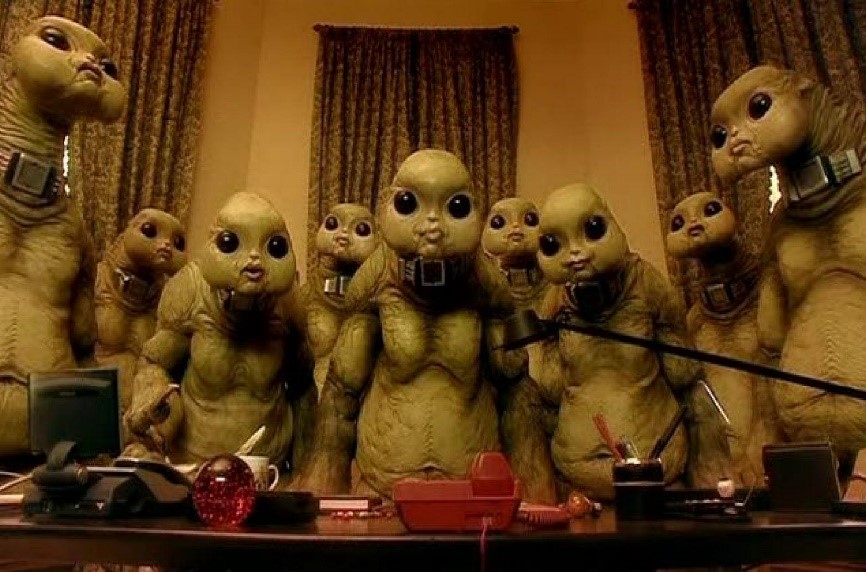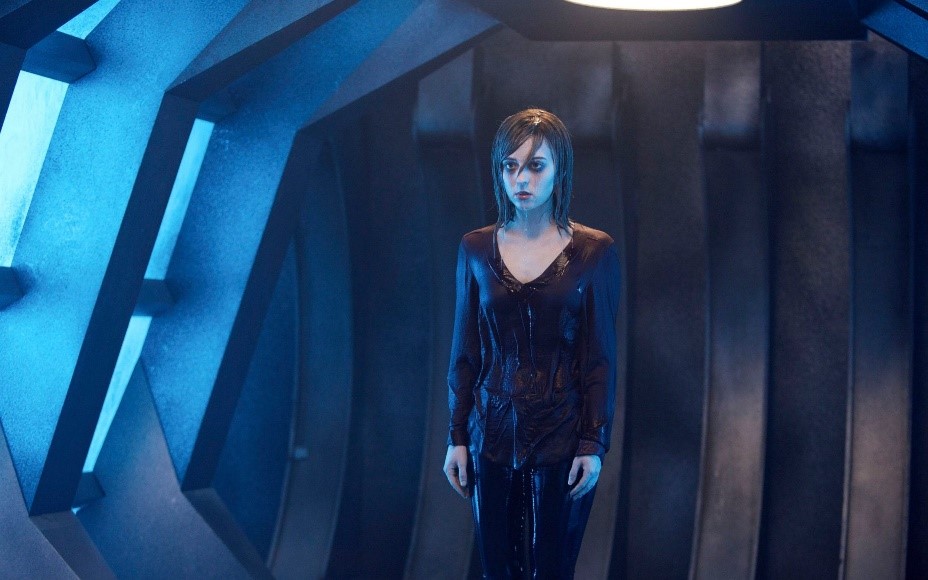
Doctor Who has its fair share of creepy capers and terrifying foes, but today we’d like to focus on the silly, gross and downright cringey monsters in the hit BBC TV show. To celebrate the recent premiere of series 12, here’s our list of monsters and villains featured in new Who, from bad to worse (spoilers ahead):
The Trickster’s Time Beetle
Season 4, Episode 11
It’s time to call the exterminator. The Time Beetle is quite the mischievous insect; it feeds on time energy and tricks the victim it clings to by altering their personal history through changing a past decision. This is a great villain concept for a show centred around time travel, but the Time Beetle’s appearance looks comical and fake.
While its omnipresence and clicking sounds are unsettling, the show never explained how the Time Beetle manages to remain invisible and undetected on Donna’s back for so long. Why can some people sense it’s there, while others cannot?
Furthermore, what does the persuasive fortune-teller stand to gain from altering people’s lives or inadvertently creating a parallel world where the Doctor is dead? Either way, this villain is enough to give us entomophobia.
Krillitanes
Season 2, Episode 3
Don’t get on this Headmaster’s bad side. The Krillitanes adopt desirable attributes of the species they encounter, which is a creative idea, but also a wild card for the writers to choose any appearance they like. As such, an oversized bat-like creature was an odd decision.
These monsters’ goal is to use intelligently-enhanced children to solve the ‘Universal Theory’, and we can’t help but laugh and think of The Hitchhiker’s Guide to the Galaxy while the Krillitanes try to find the answer.
The Krillitanes are sinister, but their oil burns them like toxic acid, which is a serious weakness for creatures that boast about their superior evolutionary adaption capabilities.

The Great Intelligence
Season 7, Episodes 6 & 13
This formless mist has a dangerous agenda. The Great Intelligence first appeared as a villain in The Abominable Snowmen during the Second Doctor’s time. A monster that uses mind control is always intriguing, but some of the new Who episodes featuring this villain are convoluted.
This monster has no physical form; it is a shapeless fog with a living mind. The Great Intelligence’s list of powers and abilities seems to have no end. It can communicate on its own, but it also commonly uses possession and various other means to achieve its goal of conquering the Earth including snowmen, Spoonheads and Whisper Men.

The Old God of Akhaten
Season 7, Episode 7
This is one pathetic parasitic planet. Akhaten, a planet-sized creature that feeds on memories, stories and emotions, and for some reason is kept at bay by… singing?

When the creature awakens, the Doctor’s approximately 1,000 years of memories are not enough to sate Akhaten’s hunger, but the leaf that caused Clara’s parents to meet is. This points out just how powerful human emotions are and how little the Doctor understands them sometimes. However, these emotions overfeed Akhaten, and it implodes because of all the feelings.
Slitheen
Season 1, Episodes 4, 5 & 11
Raxacoricofallapatorius (say that five times fast)! That’s the home-world of the Slitheen family, who are ginormous calcium-based lifeforms. The Slitheen are the alien equivalent of greedy tycoons, hoping to start a nuclear war so they can then sell off the remains of Earth as rocket fuel to the highest bidder.
Even though the Slitheen have unsettling plans, these monsters aren’t scary. Their voices sound like they are being electrocuted, the fart jokes aren’t funny, and they can be defeated by vinegar. Yes, a salad dressing is their weakness!
The Slitheen look both humorous (with their oddly-cute chubby cheeks) and unappealing (with their big, black eyes and three-clawed hands). For 2005, the CGI of these monsters running down hallways isn’t bad — but it’s still not great.

Sentient Spaceship Oil
Season 10, Episode 1
The idea of living fluid that can mimic you like a reflection sounds great on paper, but the reality of it on-screen becomes farfetched.
This sentient liquid monster is never fully explained; we’re left more confused at the end of the episode than at the beginning. It’s also a rehash of the voice-mimicking monster from Season 4 episode Midnight and viral species The Flood from The Waters of Mars Special.

Pig-Human Hybrid Slaves
Season 3, Episodes 4 & 5
Understandably, the Daleks needed to round up humans for their ghastly experiments, but why bother turning the slaves into pig hybrids? How does that improve their efficiency? We know the Daleks are the true villains of this episode, but the monsters they used to carry out their schemes were so unnecessary.
While the 1930s Great Depression setting, Hooverville characters, and Laszlo and Tallulah’s Beauty and the Beast love story were touching, the monsters were not for us.
This pork is not Dalek-table.

Jagrafess
Season 1, Episode 7
Welcome to Satellite 5, where the villains are silly. The Jagrafess is gross to look at; it’s a huge wet clump of flesh or a bad-tempered worm with teeth, who explodes because it cannot handle a little heat. Funnily enough, this monster has similarities to recurring (season 1-2) villain and former human-turned-skin trampoline, Cassandra!
And why is the Jagrafess living on the ceiling of Floor 500? Did the sassy yet submissive Editor put him there? This monster seems like something out of the pages of a Goosebumps book (not that there’s anything wrong with Goosebumps books).
Both the Editor and Jagrafess (secretly the Editor-in-Chief) characters are under-developed, and the personal gain they stand to achieve – by controlling the people of Earth via manipulating the news – is non-existent. It’s also macabre and impractical to hire a group of frozen dead people to be your office workers. These villains left us baffled.

Isolus
Season 2, Episode 11
You’ll have to draw a smile on our faces for us to be happy about this villain. The Isolus possesses 12-year-old Chloe Webber much like a lonely tantrum-throwing demon, causing her to draw people and trap them in her pictures. The promising concept of living images is explained away lazily by claiming the Isolus creates whole imaginary worlds to entertain itself as it travels through space, despite having billions of siblings to keep it company.
The cliché of the alien’s escape pod being powered by love (and also heat) is eye-roll inducing.
While the episode was aimed at a younger audience, it doesn’t excuse the Isolus. Not to mention, the exaggerated drawing of Chloe’s father that comes to life was equally creepy and ridiculous, and the giant pencil scribble that attacks Rose looked incredibly out of place.

Abzorbaloff
Season 2, Episode 10
And last, but definitely least, is the Abzorbaloff from Raxacoricofallapatorius’ twin planet, Clom, which — you guessed it — absorbs people via a single touch, leaving only their faces visible on its grotesque, pale-green body.
Love and Monsters, the episode featuring this villain, received mixed reviews. While this episode revealed the sad unromantic truth of what it’s like for ordinary citizens and the companions’ families when the almighty Doctor is away, the monster was… terrible.
The Abzorbaloff and his human alter-ego Victor Kennedy are slimy (literally and figuratively). He can’t stop waving his tongue around, in true alien form his voice sounds like a static radio, he appears to have a disturbing enjoyment of absorbing people, and he is beaten by simply breaking his cane. There’s usually one episode per season that we Whovians would rather forget, and this is it.

The sometimes-ridiculous monsters are the price we pay for an overall creative and lovable show. We can always go back to our favourite episodes when we’re sick of the lame monster of the week unless we’re in the mood for an ironic giggle! We hope you enjoyed our selection of the silliest modern Doctor Who monsters and villains. Any of your top worst picks that didn’t make our list?
You can watch Doctor Who series 12 via ABC iView and earlier seasons via Stan.










